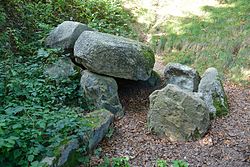Great stone grave Hademarschen
| Great stone grave Hademarschen | ||
|---|---|---|
|
The great stone grave of Hademarschen |
||
|
|
||
| Coordinates | 54 ° 7 '44 " N , 9 ° 24' 14.9" E | |
| place | Hanerau-Hademarschen , Schleswig-Holstein , Germany | |
| Emergence | 3500 to 2800 BC Chr. | |
| Sprockhoff no. | 172 | |
The Hademarschen large stone grave is a megalithic burial complex of the Neolithic funnel cup culture in Hanerau-Hademarschen in the Rendsburg-Eckernförde district in Schleswig-Holstein . The grave bears the Sprockhoff number 172. It is part of the Hademarscher Mountains , a group of stone and Bronze Age burial mounds . As the only one of these facilities to date, it was archaeologically examined by Carl Rothmann in the 1930s .
location
The grave is on the western outskirts of Hanerau-Hademarschen near a sports facility. From the Hademarsch Mountains there are still four more of what were originally more than 30 burial mounds.
description
The complex is an east-west oriented passage grave of the Holstein Chamber subtype with a length of 3 m and a width of 1.5 m. There are three pairs of wall stones on the long sides and one end stone each on the narrow sides, all of which are still in situ . Of the three original capstones, the western and central ones have been preserved. They are still on the wall stones. The access to the chamber is located between the eastern and central wall stones on the south side. In front of this was originally an approximately 2 m long and almost 0.5 m wide corridor made of two pairs of wall stones, which consisted of two pairs of wall stones. Only the two western gangestones are preserved. The only surviving grave goods of the funnel beaker culture were a few shards of ceramic vessels.
During the late Neolithic, the burial chamber was reused by members of the individual grave culture (2800–2300 BC). From this occupation phase, skull bones of seven adults and one child have been preserved. Five ceramic vessels, three daggers and a hatchet made of flint and two cut axes made of rock were found as grave goods.
In the Bronze Age around 1200 BC. Another grave was laid out directly above the chamber. The remains of an oak coffin were found inside a pack of stones the size of a head. Skeletal remains were not preserved. The grave goods (a gold bracelet , a spout hatchet and a sword made of bronze as well as two ceramic vessels) indicate a high social position of the buried person.
literature
- Carl Rothmann : Stone Age burial chamber with an overlying skeleton grave from the Bronze Age near Hademarschen. In: Gustav Schwantes (Ed.): Festschrift for the centenary of the Museum of Prehistoric Antiquities in Kiel. Wachholtz, Neumünster 1936, pp. 52–61.
- Ernst Sprockhoff : Atlas of the megalithic tombs of Germany. Part 1: Schleswig-Holstein. Rudolf Habelt Verlag, Bonn 1966, p. 46.
Web links
- The Megalithic Portal: Hanerau Hademarschen stone grave

